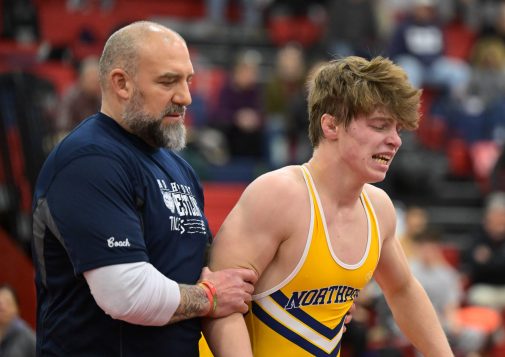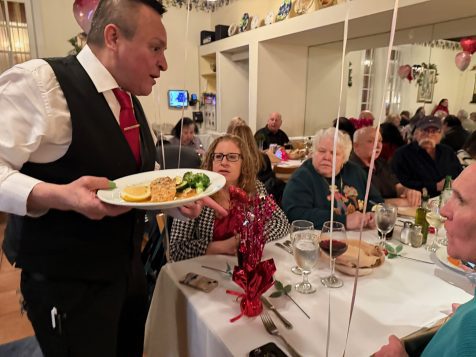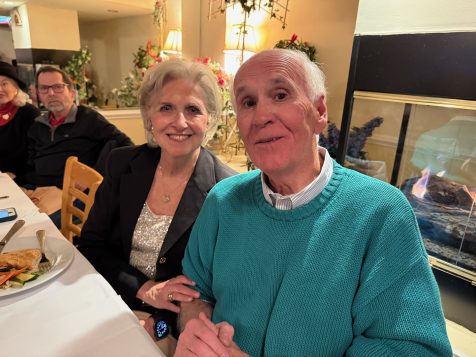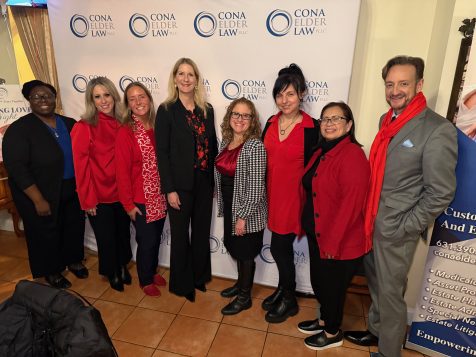By Steven Zaitz
On Wednesday, Feb. 5, Northport High School wrestler Kingston Strouse was playing his saxophone in 9th period band class when the senior was asked to report to Athletic Director Mark Dantuono’s office.
When he arrived, he found his coach of four years, Thad Alberti, sitting in that office stone-faced and glum.
Alberti informed Strouse, who is ranked first in his weight class in Suffolk County, that due to an administrative error, he, along with five of his teammates, were ruled ineligible for post-season competition. There would be no League Championships, which was just days away, for Strouse and his mates.
That was the first domino — without Leagues, there was no path to Suffolk County or State championship tournaments.
As per New York State Public High School Athletic Association policy, a wrestler who exceeds the maximum number of tournaments, which is six, is ineligible for the remainder of the season and the coach of the wrestler is suspended from the team’s next two scheduled competitions. The reason for the rule is that wrestlers accumulate points over the course of the season and a wrestler who participates in extra matches will have potentially gained more points than his competitors.
“When I was first told the news, I remember being shocked, but I don’t think I had a single ounce of hate or a single ounce of regret for anything that had happened,” Strouse said. “I just remember feeling bad for my coach because he was sitting there and he just looked devastated. I was more concerned about how other people were feeling about the situation and I thought that if we really were together, we could get it overturned. I knew we were going to put up a fight about this.”
His teammates were more concerned about Strouse.
“Kingston is our leader and being that he’s a senior, I really felt terrible for him,” said teammate Peyton Hamada, who was one of the six also suspended. “I was more upset for him than I was for myself.”
As of Wednesday night, the season was over for Strouse, juniors Hamada and Lucas Rivera, sophomores Sebastian Stabile and Tyler Naughton and freshman Ryan Muller.
But it was Strouse– because of his top ranking in Suffolk County at 152 pounds, his stature on the team and his storied four-year career as a Northport wrestler –who became the face of this soon-to-be exploding media frenzy. The other kids will wrestle for Northport next year. Strouse will not.
The story was first reported by Newsday’s Gregg Sarra, who is the editor of the paper’s high school sports section. As of Feb. 6, he reported that the ‘Northport Six’ were disqualified, and as per Section XI Chief Tom Combs, the rule was clear-cut and the matter was now closed.
But the matter was not closed.
As social media became ablaze with the news, opinions for and against these Northport athletes being allowed to compete were split. Some were compassionate, not wishing the boys to be punished for a mistake that they themselves did not make.
But others were unsympathetic, posting that Northport has to play by the rules like everybody else. One post on X read “typical Northport athletics, always breaking the rules and never paying for it. Mistake my (foot)”.
As the Long Island wrestling world debated, the guys on the team, the booster club and the Northport and wrestling communities banded together with a plan of action. They set up a GoFundMe page that raised nearly $9,000 to retain a legal team to fight this in the courts. Attorneys Anthony Camisa and James Pascarella, both former Long Islanders wrestlers, were brought in.
The group, including the six wrestlers and some of their parents, travelled to the courthouses in Riverhead on Friday and were able to appear before Suffolk County Justice of the Supreme Court Peter R. McGreevy on an emergency basis. The League III championships were going to start — with or without these guys — in less than 24 hours.
“I told the kids and the parents that all I can do is get you guys before a judge and once that occurs, nobody knows what will happen,” said Camisa, who was a wrestler at Longwood and University of Albany before he passed the bar exam. “In this case, the kids did nothing wrong and not being able to wrestle would have caused them irreparable harm. I think that was the part of our argument that got us our stay.”
Strouse, who had been fighting a nasty cold all week, was ecstatic at the favorable result.
“When we got down there, it really seemed like we weren’t going to win the case and be able to wrestle,” said Strouse. “Everything was kind of stacked against us, so I can’t even put into words how grateful I am to the lawyers that were able to get this done. But I’m also grateful to the Northport community and the wrestling community as well. It’s a lot smaller than other sports and wrestlers back each other up. A lot of my friends from other schools on Long Island were reaching out to me, being supportive, and sending out our GoFundMe link. There are a lot of people to thank for this.”
It was now time to focus on wrestling
Strouse, still not at 100% strength due to his cold, now had to get ready for the match. He prowled around the Smithtown East gym with a hoody over his head, waiting for his turn.
When it came time, he beat both Andrew Schwartz of Newfield and John Zummo of Smithtown East handily but it would be close to three hours before his final match against North Babylon’s Jack Miller. He waited. He listened to his music. He took a nap in the bleachers until the match with Miller arrived.
Ahead in points for most of the contest, a sudden scramble at the beginning of the third period against Miller caused an awkward twist of Strouse’s left knee. As he lay face down on the mat, writhing in pain, it looked for sure that Strouse’s roller coaster week wouldn’t quite make it to its final turn. His day seemed done.
With his coach, Chris Posillico, who filled in for the suspended Alberti, and Strouse’s worried mom Lori looking on matside, Strouse rose to his feet.
After a few flexes of his leg and a swig of water, the match continued.
“Yeah, it was bad,” Strouse said. “But it wasn’t structural, so it was just a matter of dealing with the amount of pain that we sometimes have to deal with in this sport.”
Strouse powered through, won the match 14-5, and this long, grueling, but ultimately satisfying week was finally done. However, his journey is not. Despite his lingering illness and the issue with his knee, Strouse will compete for a county championship this weekend at Stony Brook University.
“Everything I did on the mat today just didn’t feel right,” said Strouse. “Every shot I took wasn’t fast. My decision making wasn’t on. I just felt so foggy and weak. Plus, I couldn’t breathe out of my nose. It seemed like everything was just stacked against me, but I got the job done, so I guess that’s all that matters.”
Yes, Strouse did his job on the mat, but without his eclectic crew of 11th-hour partners from all across Long Island, there would never have been a job for him to do.


















































